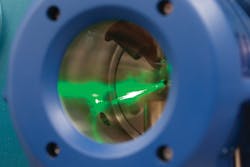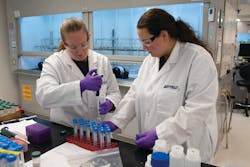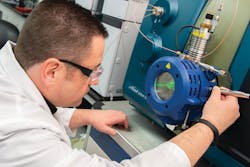Battelle scientists tackle pressing environmental crisis
As concern about per- and polyfluoroalkyl substances (PFAS) intensifies, so too does the race to better understand these chemicals and identify a way to destroy them. One organization joining the crusade to fight PFAS is the 90-year-old research giant, Battelle, whose work has been instrumental in the development of such ubiquitous items as aluminum foil, copy machines, and bar codes.
The 501(c)(3) non-profit entity has at its core a mission of science for societal benefit. “So this complex issue of PFAS really fits within our DNA,” said Battelle’s PFAS program manager, Amy Dindal.
Battelle has been researching PFAS and its effects for over a decade. “We’ve been investing significantly over the last year in particular, looking at different technologies and solutions for PFAS whether it be remediation, monitoring, or assessment,” Dindal said. “And what we’ve learned is that these substances are significantly different than other environmental contaminants that we’ve had to deal with in the past.” Specifically, she explained, it’s that carbon-fluorine bond that makes them so useful in so many different applications that also makes them very difficult to remediate.
Adding another layer of complication is the variety of matrices that need to be considered. “We have traditional matrices like groundwater and soil and sediment, but because of the interest in PFAS and how it’s entering our environment, there are [also] things like landfill leachate and biosolids, which are much more complex,” said Dindal.
Earlier this year, Battelle received accreditation for testing four new PFAS compounds in its lab in Norwell, Massachusetts, making it the leading PFAS testing lab in the country. “It is an accredited laboratory that can work nationwide for the Department of Defense, and we also have accreditation in many other states as well,” Dindal explained.
As a research organization, Battelle is also focused on doing method optimization and new method development. “In fact, at our Columbus, Ohio, headquarters, we’re working on things like developing signatures of PFAS in different source materials and also developing assays to look at total fluorine and total PFAS in different environmental matrices.”
Given the persistent nature of PFAS chemicals — often referred to as “forever chemicals” — addressing the water quality challenge before us can seem daunting. “Water and wastewater treatment providers are in a very difficult position,” said Dindal, “because they are secondary receivers of the PFAS compounds; they’re not using them themselves or generating them as part of the projects that they’re doing.”
But on the bright side, some of the traditional techniques used for treating other drinking water contaminants can be used for PFAS. These include granular activated carbon and ion exchange resins.
In the case of the wastewater treatment processes, however, Dindal noted that there are some continuing concerns about what happens with materials at the end of the process (i.e., biosolids). Incineration is one disposal method, “but it’s not known yet if there’s a deleterious effect that’s happening,” she said.
This is a key area of research for Battelle scientists, who want to understand what exactly happens to these materials as they are being remediated through incineration. “Are the PFAS truly being destroyed? Or are PFAS residuals remaining, such that they are in the ash or potentially being redeposited on the surrounding environment through the flue gas emissions?” said Dindal.
Fortunately, Dindal added, there is a lot being done in terms of collaboration and understanding the information that’s available. “It’s being shared with organizations like the Interstate Technology and Regulatory Council, who are producing fact sheets and sharing information so that we can at least gain some knowledge together and leverage the information that’s being produced in the industry.”
As for the future of PFAS research, Dindal said Battelle’s main focus is on complete destruction of PFAS compounds. “Those traditional approaches that I mentioned earlier — granular activated carbon and ion exchange resins — they transfer the PFAS material from one source to another, so you still have to address the PFAS in the materials that are absorbing them.” Early results of Battelle’s work are very encouraging, she said. “We’re hoping to be able to share more very early in 2020.” WW
About the Author

Angela Godwin
Editorial Director
Angela Godwin is the previous editorial director for Endeavor Business Media's Process/Water Group.


